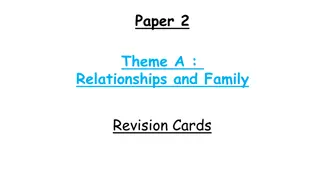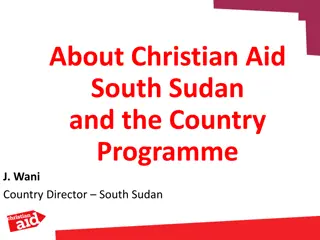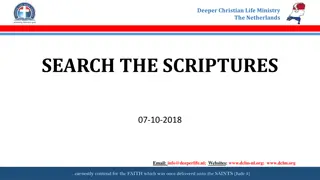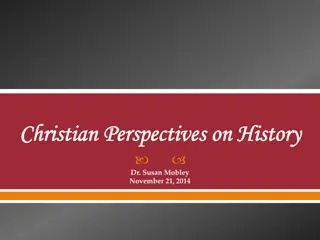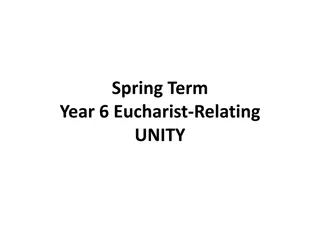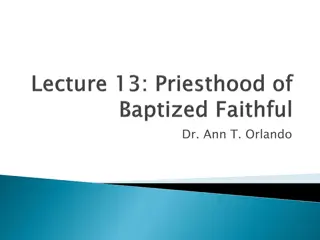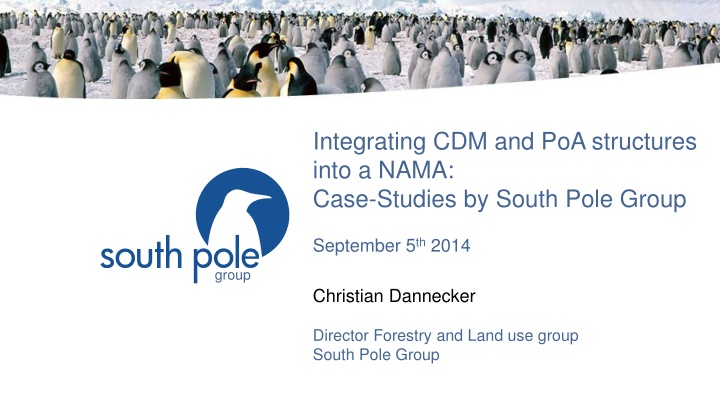
Integrating CDM and PoA Structures into a NAMA: Case Studies and Implementation Insights
Explore how the integration of Clean Development Mechanism (CDM) and Programmatic Approach (PoA) structures into Nationally Appropriate Mitigation Actions (NAMAs) benefits countries in achieving emission reduction targets. Case studies from Indonesia and Switzerland showcase innovative regulatory frameworks and financial mechanisms driving sustainable development.
Uploaded on | 1 Views
Download Presentation

Please find below an Image/Link to download the presentation.
The content on the website is provided AS IS for your information and personal use only. It may not be sold, licensed, or shared on other websites without obtaining consent from the author. If you encounter any issues during the download, it is possible that the publisher has removed the file from their server.
You are allowed to download the files provided on this website for personal or commercial use, subject to the condition that they are used lawfully. All files are the property of their respective owners.
The content on the website is provided AS IS for your information and personal use only. It may not be sold, licensed, or shared on other websites without obtaining consent from the author.
E N D
Presentation Transcript
Integrating CDM and PoA structures into a NAMA: Case-Studies by South Pole Group September 5th2014 group Christian Dannecker Director Forestry and Land use group South Pole Group
How do a PoA and a NAMA play together? KfW (2011: On the Road from PoA to NAMA *), using four case-studies, showed that PoA provide important building blocks for NAMA design. Countries are starting to build on this by combining two regulatory instruments: Instrument 1 sets a target, allows the use of certain performance based payments (like carbon credits) to contribute towards target compliance (creates demand). Instrument 2 (derived from CDM-PoA) facilitates meeting any performance gap via the supply of eligible carbon credits (often under domestic governance scheme) (creates supply). Together they form a market (demand and supply) and represent a NAMA. Early Action Programme rewards the early-movers and effectively creates an incentive bridge between today and a future agreement. Regulatory Regulatory Instrument 1 Instrument 2 (PoA-style) Mechanism that creates supply of eligible carbon credits Sets target and creates demand for carbon credits NAMA *South Pole (2011): How to develop a NAMA by scaling-up ongoing programmatic CDM activities ; http://www.jiko-bmu.de/files/basisinformationen/application/pdf/south_pole_study_poa_to_nama_june_2011.pdf 2
Case-study 1: Indonesia Cement Industry Regulatory Context: Current regulation covers 9 largest cement producers in Indonesia, seeks to reduce GHG emissions by 2% p.a. by 2015 / additional 3% p.a. by 2020. The companies may use carbon credits originated in this and downstream sectors of the economy to meet the target. Proposed Implementation Arrangement: Development of a domestic offset procurement programme from the cement producers if they go below their historic carbon intensity dynamic benchmarks. The programme is organized within a PoA-style framework and governed by a domestic framework of rules modeled on the CDM. Preceded by readiness work like MRV setup. Introduction of a moderate tax on all coal exports to extend the availability of coal for domestic consumption, to increase competitiveness of the national industry, and to finance the procurement of carbon credits from over-complying cement factories (and possibly from downstream sectors such as housing). Flow of Finance: ER purchase funded out of a) revenues from coal export tax, b) domestically and internationally supported funds for NAMA, c) from other domestic policy schemes, and d) international carbon markets (in this case ERs would have to be cancelled by buyer, not NAMA host). GHG emission reduction regulation + moderate tax on all coal exports PoA domestic carbon procurement scheme NAMA 3
Case-study 2: Switzerland KLiK Foundation Regulatory Context: Swiss CO Law requires producers of motor fuels to offset on average 5% of CO emissions (2013-20). To meet this target they fund GHG reductions stemming from eligible carbon projects in Switzerland. Implementation Arrangement: Development of a domestic carbon credit procurement scheme organized within a domestic PoA-style framework. Establishment of the Foundation for Climate Protection and Carbon Offset (KLiK) funded by a small fee from 39 mineral oil companies to facilitate climate mitigation projects in Switzerland. KliK is tasked to act as a carbon offset accumulator and fulfil their carbon offset obligations under the Swiss CO Law. Flow of Finance: KLiK buys carbon units generated domestically from mitigation projects in the fields Transportation, Businesses, Buildings and Agriculture. Swiss CO Law + KLiK Foundation funded by fees from mineral oil companies PoA domestic carbon procurement scheme NAMA 4
Case-study 3: Colombia Urban Transport Regulatory Context Colombia PMR program aims at developing market-based instruments for the transport sector. Proposed combination of 3 NAMAs (public urban transport, non-motorized transit, and NAMA for performance standards in vehicles) will result in a domestic offset scheme (open only to transport emission reductions, and funded domestically by a relocation of part of the existing low carbon tax on liquid fuels). The NAMAs will accept certain carbon credits from existing transport PoA-style and CDM projects. Domestically- funded and internationally supported purchases of credits will be counting towards the future Colombian NAMA target. Proposed Implementation Arrangement: o Development of the domestic offset scheme based on the existing Swiss domestic offset scheme for transport. o Design of the NAMAs and relocation of the moderate tax on liquid fossil fuel to spur domestic demand. Flow of Finance: Demand from a) domestic fund b) international NAMA donors (support) c) carbon credit buyers (credited) and, again, CER sales still possible. Domestic Tax + Supported / Credited NAMAs to create Demand Domestic Offset Scheme to create Supply PMR Colombia: comb. of 3 MBIs 5
Thank you! For more info: Booth 12 Christian Dannecker Director Forestry and Land Use South Pole Group c.dannecker@southpolecarbon.com 311-7870924 group Manuel Cocco Climate Policy (NAMA) Lead South Pole Group





